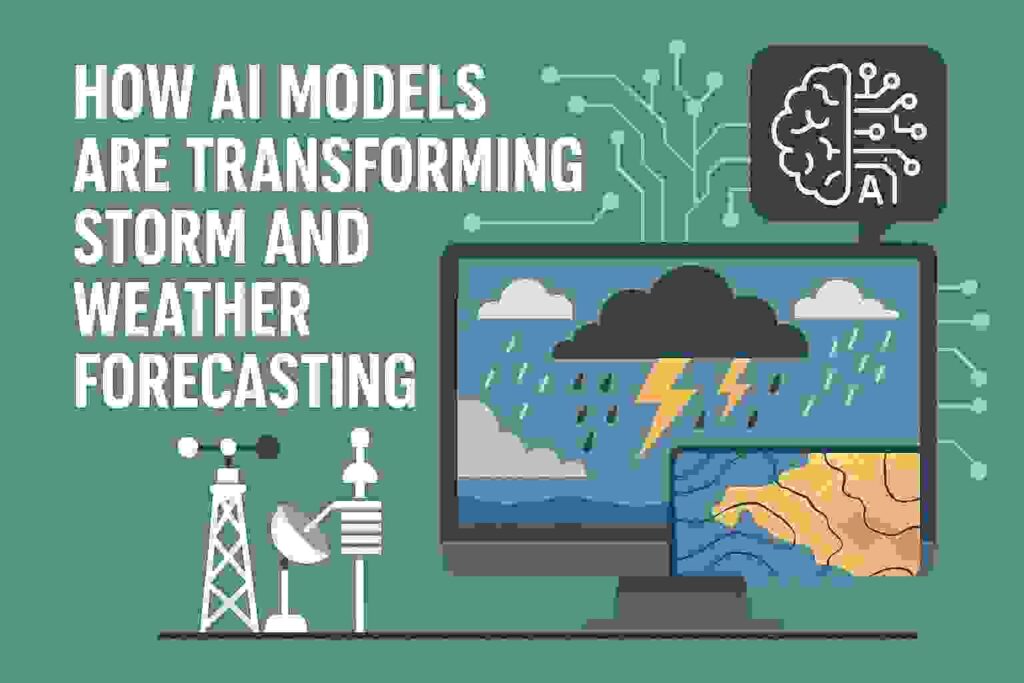For decades, weather prediction relied on supercomputers crunching physics-based models. These systems were powerful but slow, often taking hours to produce forecasts. Today, artificial intelligence (AI) is rewriting the rules. Instead of depending only on traditional simulations, new AI models can process massive streams of climate data and deliver forecasts in minutes—sometimes seconds.
This shift is not just a technological upgrade. Faster, more accurate forecasts mean lives saved, better disaster planning, and smarter responses to extreme weather.
From Supercomputers to AI Models
Conventional weather forecasting uses numerical weather prediction (NWP). It relies on equations describing the atmosphere and oceans. The challenge? These models require immense computing power and still carry delays.
Enter AI-powered systems like Aurora, GraphCast, and Earth-2 digital twins. Instead of solving equations step by step, they learn patterns directly from decades of climate and satellite data. Once trained, they can predict how a storm will evolve or how temperatures will shift almost instantly.
This is a breakthrough because speed matters. In the case of a cyclone or flash flood, minutes can mean the difference between evacuation and disaster.
Forecasting Storms With Greater Precision
Recent tests have shown that AI weather models can outperform traditional forecasts in tracking storm paths and intensities. For example:
- Hurricanes and Cyclones: AI models can analyze historical storm data and current satellite readings to predict not just where a storm will land, but how strong it will be.
- Flood Risks: By combining rainfall, soil, and river data, AI can forecast flooding with finer detail, helping local authorities prepare ahead of time.
- Solar Storms and Space Weather: AI isn’t limited to Earth. Models are now being used to predict solar activity, which can disrupt satellites and power grids.
The result? More accurate warnings that help governments, businesses, and citizens stay one step ahead.
Air Quality and Climate Benefits
It’s not only about storms. AI is also making strides in air quality monitoring. Models can forecast pollution levels and track wildfire smoke across continents in real time. This helps health agencies issue alerts, schools decide whether to keep children indoors, and vulnerable populations take precautions.
On the climate front, AI is helping scientists understand long-term changes, such as shifting monsoons or rising heat waves. By running countless simulations quickly, AI makes it easier to test “what if” scenarios and shape smarter climate policies.
Challenges and Concerns
Despite the promise, AI forecasting isn’t a magic wand. These systems are only as good as the data they’re trained on. If the input is biased, incomplete, or faulty, predictions can fail. There’s also a trust factor—many meteorologists remain cautious, wanting to verify AI results against traditional methods before relying on them completely.
Another concern is transparency. AI models can sometimes act like a “black box,” making predictions without showing the reasoning. Building confidence means developing ways to interpret and explain those outputs.
A Future of Hybrid Forecasting
Most experts agree the future won’t be AI vs. traditional forecasting—it will be both working together. Supercomputers will continue running physics-based models, while AI will provide faster, sharper updates. This hybrid approach promises forecasts that are not only quicker but more reliable.
Imagine a world where an AI model instantly warns of a storm forming in the ocean, and a traditional system confirms the details within hours. Emergency services would get the best of both worlds: speed and accuracy.
Final Thoughts
AI is rapidly transforming weather prediction from a slow process into a real-time, adaptive system. Whether it’s storms, floods, or air quality, these models are helping societies prepare better, protect lives, and adapt to a changing climate.
We’re entering a future where AI doesn’t just forecast the weather—it helps us live with it more safely.
Also read:




